
Simien Mountains National Park
Simien Mountains National Park - Massive erosion over the years on the Ethiopian plateau has created one of the most spectacular landscapes in the world, with jagged mountain peaks, deep valleys and sharp precipices dropping some 1,500 meters. The park is home to some extremely rare animals such as the Gelada baboon, the Simien fox and the Walia ibex, a goat found nowhere else in the world.
In some places rain has eroded the more recent rocks, exposing the original rocks. Nowhere is this more prominent - and stunning - than in Ethiopia's northern Simien region. This was the epicentre of much volcanic activity about forty million years ago, and the resulting outpouring of a boiling mass of white-hot lava reached a thickness of some 3,000 metres (9,840 feet) in this area before it stopped. Subsequent erosion of this volcanic core has produced the dramatic highs and lows of the Simicns: deep precipices and gorges, tall pinnacles of jagged rock, and weird, withered landscapes.
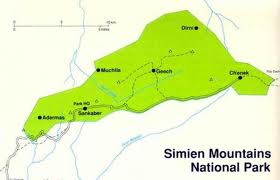
The region includes many summits above 1,000 metres (13,0001 feet), and culminates in the highest point in Ethiopia, Ras Dashen, which at 4,5-13 metres (14,901 feet), is also Africa’s fourth highest mountain. It is not a difficult mountain to climb and can be reached by travelling through the Simien Mountains National Park.
The base from which to explore the small, 179-square-kilo-metre (111-square-mile) park is Debark, 748 kilometres (464 miles) north-west of Addis Ababa and 101 kilometres (63 miles) north of Gondar.
The first thing any visitor must do is rent pack and riding animals and hire guides for the six-hour trip into the park. Although it helps to inquire in Addis Ababa before you leave concerning dealers and current prices, the hiring of guides, mules, and muleteers is done through the national park head-quarters.

As the only 'motorable' dry weather road in the park - up to Sankaber Camp - is not always in good condition, transport of the four legged variety is by far the more reliable means of getting around.
Suitable clothing for extreme temperatures are needed as the diurnal swing is considerable. Waterproof clothing is also necessary, as are a hat and sunscreen lotion: at these altitudes the sun can burn fiercely. Water is available from the various streams but should be treated. It is wise to remember that the main luggage is loaded on mules for the day, so the day's needs should be carried in a separate pack.
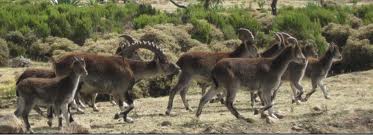
There are various campsites and tracks to follow and it is best to take the advice of the guides. The topography of this park will remain in the mind forever. Climbing up from Debark on mules, through extensive farmland, the visitor is unanawre of the dramatic scenery about to unfold. The land forms various small plateaux, and the edges of these plunge dramatically to the lowlands to the north and east. The gorge edges form a perfect habitat for the animal that the park was set up to protect - the Walia ibex.
Generally the first stop is Sankaber Camp, a trek that leads mainly through cultivated areas to the 3,230-metre (10,600-foot) campsite. From this point, visitors can walk to the edge of the abyss, where they may get their first glimpse of the spectacu¬lar scenery. Much of the vegetation has been altered by humans over the years and few trees will he seen in the area except the introduced eucalyptus. But in inaccessible areas, such as the escarpment, natural habitats are preserved and plants such as St. John's wort and heather arc seen as small trees or bushes, and many smaller herbs form carpets of colour. Among these are many species of Alchemilla, the tall spikes of various 'red-hot pokers', and carpets of small blue lobelia flowers.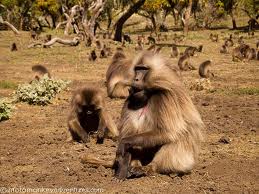
Probably the easiest animal to see in this area is the endemic gelada baboon, which grass eaters and will often be seen in family units, one male guarding his harem of females and young-ones. They are also known as the 'bleeding heart baboons' from the red areas on the chest that show the sexual stale of the animal. The klipspringer may be seen on rocky areas, its hooves specially adapted to leaping from rock to rock. The small grey duiker inhabits any area where there is enough cover to protect it from enemies.
Though named after this area, the Simien fox, also referred to as the Simictl jackal or Ethiopian wolf, is now very rare here,with only about thirty animals remaining. They are more common in Bale Mountains National Park in the south. Its high-pitched call may be heard at night, and its bright red coat is distinctive if seen during the day. It feeds on the many species of rodents found here.
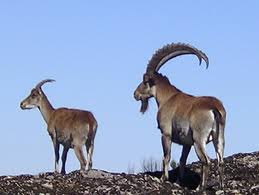
The animal most visitors wish to see is the Walia ibex. Ibis member of the wild goat family has magnificent heavily ndged horns sweeping back over the shoulders. The Walia live On the crags of the steep escarpment, their hooves clinging to the smallest ledge.
The birds here often provide spectacular acrobatic displays off the sheer cliffs, using the air currents peculiar to the terrain. Lammergeyers and choughs are present, as well as endemics such as the thick-billed raven, black-headed siskin, white-col¬lared pigeon, wattled ibis, white-billed starling, spot-breasted plover, and white-backed black tit.
From Sankaber, the track leads through meadows, forests, and some cultivated areas to Geech, a three- to three-and-a-half-hour trip by mule. Geech, at 3,660 metres (11,800 feet), is worth a stay of at least two days: there are several good lookout spots where one may see Walia, gelada, and klipspringcr, and breath¬taking views from nearby peaks.
From Geech to the next stopping-off point, Ch'enek, the journey takes another two-and-a-half to four hours, and trekkers may have to dismount and walk part of the way where the climb is steep. The Ch'enek campsite offers superb views, and there are many places to see Walia ibex. There are also caves to evnlore. and this is the only place in the park where — if extremely lucky – one can see rock hyrax, the small mammal that looks like an overgrown guinea pig hut is distantly related to the elephant.
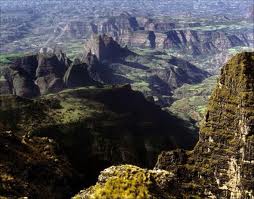
After Ch'enek, the traveller usually returns to Sankaber (three to four hours) and then Debark (five to six hours). But if arranged in advance, more extensive trips can be made to Buahit, at 4,437 metres (14,550 feel), which is outside the national park; Ras Dashen, Ethiopia's highest peak at 4,543 metres (14,901 feet); and the lowlands. Three game scout camps exist in the lowlands at Dirni, Muchila, and Adermas; but a trip here is a real expedition and recommended only for the more hardy people able to walk under tough conditions and cope with rock climbing. A trip from Ch'enek along the foot of the escarpment to the Wolkayit Pass and Debark lasts about five to seven days.
Semien Mountains National Park - Documentary Videos
Semien Mountains National Park video clips.


